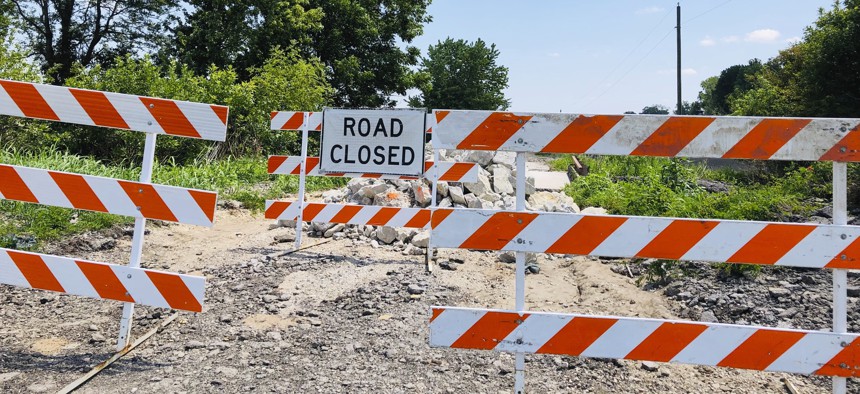Beyond Sticker Shock: Experts Urge Congress to Rethink Infrastructure Priorities

In this July 27, 2019, photo, signs block access to a bridge on a rural road in Callaway County, Missouri, on July 27, 2019. The road's approach to the bridge was washed out by flooding that began in late May and extended into early July. AP Photo/David A. Lieb

Connecting state and local government leaders
Policy experts say lawmakers should think more broadly about infrastructure goals rather than just focusing on a dollar amount to be spent.
Rather than focusing on the cost to address American infrastructure needs, Congress should rethink its priorities in spending, infrastructure policy experts told a House Committee on Wednesday.
The estimated cost to address the United States’ infrastructure backlogs is $4.6 trillion. But as nobody expects the Trump administration and Congress to come together on a big infrastructure package and lawmakers remain embroiled in an ongoing debate over how to pay for transportation projects that can no longer be supported solely through the existing federal gas tax, the House Budget Committee on Wednesday heard from policy experts advocating for an overhaul of how the federal government approaches infrastructure projects.
“Spending is not an outcome,” said Adie Tomer, a fellow with the Brookings Institution’s Metropolitan Policy Program. “To enact genuine reform, we must be willing to revisit the fundamental goals we hope to achieve. We also must execute an honest assessment of whether our current policy frameworks share those objectives.”
While much of the conversation around infrastructure focuses on roads, highways, transit projects and bridges, the federal government must look beyond those types of projects, said Christopher Coes, the vice president of land use and development at Smart Growth America.
“To make communities investment-ready, federal investment has to go beyond just roads and bridges and public transportation,” Coes said. “It is imperative that the federal investments also include brownfields, water management, and broadband access which are critical infrastructure for communities of opportunity.”
Some lawmakers seemed receptive to the idea, highlighting either non-traditional infrastructure needs in their own communities or outside-the-box solutions to growing transportation problems.
Rep. Jason Smith, a Missouri Republican, said nine of the 30 counties he represents do not have their own 911 emergency service.
“You are talking about better roads and bridges. My people need to have 911 service,” he said, highlighting the urban and rural divide on basic services.
To address traffic congestion, Rep. Seth Moulton, a Massachusetts Democrat, pointed to an initiative in Virginia that sought to reduce long-haul truck traffic on roadways by investing more in railways.
“One single train can carry 300 trucks,” he said. “Let’s make sure we are making investments not based on the status quo to simply repair our roads and bridges as we always do… but truly making smart, fact-based business savvy investments in 21st century infrastructure after examining all options on the table.”
Tomer said he does believe the U.S. needs to spend more to address infrastructure needs, but suggested areas like digitalization should be more highly prioritized. As an example, he noted the fact that to even rent one of the scooters proliferating in cities across the country, users need to not only have smart phones but also have access to digital banking services and wireless internet.
Lawmakers also raised concern about the dwindling amount of Highway Trust Fund money available. The fund is paid for through revenues from the federal gas tax, which have been on the decline as a result of Americans’ increased use of more fuel-efficient cars. Republicans in Congress have been opposed to raising the federal gas tax and lawmakers have sought to identify other ways to pay for transportation infrastructure, such as taxes that target how much people actually drive.
Rep. Bill Johnson, an Ohio Republican, raised the issue at the committee hearing, noting that while motorists who use roadways should be the ones who pay for the infrastructure, there should be a component to address the inequities of implementing a use tax on rural areas where residents have to drive long distances on a daily basis.
“Who are the ones that are the most disproportionately affected by a use tax? It’s those that live in rural America who have to drive 30 or 45 minutes to get to work or the hospital or the grocery store or to check on mom and dad,” Johnson said.
Given the funding challenges involved in infrastructure improvement projects, experts said federal and state governments should look for new ways to leverage local assets.
R. Richard Geddes, director of the Cornell Program in Infrastructure Policy at Cornell University, provided one such example, suggesting the federal government could do away with restrictions that have prevented state governments from building out hundreds of interstate rest stops.
“If states had the option of developing those rest stops they could concession out the food, concession out the rest stops and gain new funding for infrastructure through those concessions,” he said.
Andrea Noble is a staff correspondent with Route Fifty.

NEXT STORY: A Loan Fund Aims to Spur Development Along a Midwest Commuter Rail Line




